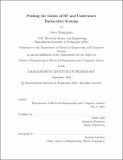Pushing the Limits of RF and Underwater Backscatter Systems
Author(s)
Rodriguez, Osvy
DownloadThesis PDF (6.467Mb)
Advisor
Adib, Fadel
Terms of use
Metadata
Show full item recordAbstract
Backscatter communication systems, in both air and water, are great alternatives to traditional communication systems due to their low power requirement. The fact that backscatter systems can communicate at near-zero power makes them desirable for long-term applications such as environmental monitoring, asset tracking, and batteryless localization. However, backscatter systems are usually constrained by a limited operational range of a few meters. This limitation is generally due to the low power nature of the backscattered signal. In the case of batteryless backscatter systems, this range becomes more limited by the harvested energy efficiency of these systems. In this thesis, I explore different aspects of in-air and underwater backscatter communication. In airborne media, I explore the limitations of an end-to-end radio frequency (RF) backscatter localization system through the characterization of each component and validate a theoretical model to estimate its limited range under different conditions. In the context of underwater backscatter, I propose an ultra-wideband underwater backscatter system based on a novel metamaterial transducer and evaluate the system in controlled and uncontrolled environments, showing that it achieves more range and more throughput than prior state-of-the-art underwater backscatter designs. In doing so, this thesis extends our understanding of RF backscatter and advances the capabilities of underwater backscatter for next-generation energy-efficient communications.
Date issued
2022-09Department
Massachusetts Institute of Technology. Department of Electrical Engineering and Computer SciencePublisher
Massachusetts Institute of Technology